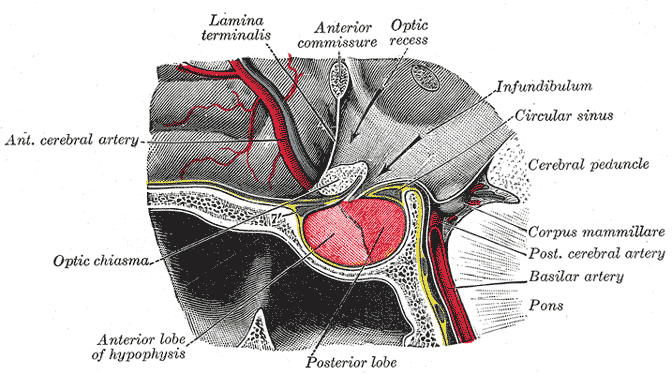Sandbox:hypopituitarism pathophys: Difference between revisions
Jump to navigation
Jump to search
| Line 14: | Line 14: | ||
===Pathogenesis=== | ===Pathogenesis=== | ||
Hypopituitarism pathogenesis | *Hypopituitarism pathogenesis is mainly due to destruction of the gland cells by different ways like ischemia, inflammation or infiltration.<ref name="pmid12675508">{{cite journal| author=Arafah BM| title=Medical management of hypopituitarism in patients with pituitary adenomas. | journal=Pituitary | year= 2002 | volume= 5 | issue= 2 | pages= 109-17 | pmid=12675508 | doi= | pmc= | url=https://www.ncbi.nlm.nih.gov/entrez/eutils/elink.fcgi?dbfrom=pubmed&tool=sumsearch.org/cite&retmode=ref&cmd=prlinks&id=12675508 }} </ref> | ||
==== | |||
==References== | ==References== | ||
{{Reflist|2}} | {{Reflist|2}} | ||
Revision as of 20:48, 7 July 2017
|
Hypopituitarism Microchapters |
|
Diagnosis |
|---|
|
Treatment |
|
Case Studies |
|
Sandbox:hypopituitarism pathophys On the Web |
|
American Roentgen Ray Society Images of Sandbox:hypopituitarism pathophys |
|
Risk calculators and risk factors for Sandbox:hypopituitarism pathophys |
Editor-In-Chief: C. Michael Gibson, M.S., M.D. [1] Associate Editor(s)-in-Chief: Ahmed Elsaiey, MBBCH [2]
Overview
Pathophysiology
Background on pituitary gland blood supply
- In order to understand the pathophysiology of hypopituitarism, it is necessary to know the blood supply of the pituitary as the disease occurs mainly by ischemia through different mechanisms like hemorrhage, tumors or brain injury.[1][2]
- Pituitary gland is composed of two parts anterior (adenohypophysis) and posterior (neurohypophysis). Both parts are supplied by the carotid arteries.
- Adenohypophysis: It receives blood supply from the long and short hypophyseal arteries which arise from the internal carotid artery and the anterior of circle of willis.
- Neurohypophysis: It receives the blood supply from the inferior and middle hypophyseal arteries.

Pathogenesis
- Hypopituitarism pathogenesis is mainly due to destruction of the gland cells by different ways like ischemia, inflammation or infiltration.[3]
References
- ↑ Dusick JR, Wang C, Cohan P, Swerdloff R, Kelly DF (2012). "Pathophysiology of hypopituitarism in the setting of brain injury". Pituitary. 15 (1): 2–9. doi:10.1007/s11102-008-0130-6. PMC 4170072. PMID 18481181.
- ↑ Schneider HJ, Aimaretti G, Kreitschmann-Andermahr I, Stalla GK, Ghigo E (2007). "Hypopituitarism". Lancet. 369 (9571): 1461–70. doi:10.1016/S0140-6736(07)60673-4. PMID 17467517.
- ↑ Arafah BM (2002). "Medical management of hypopituitarism in patients with pituitary adenomas". Pituitary. 5 (2): 109–17. PMID 12675508.